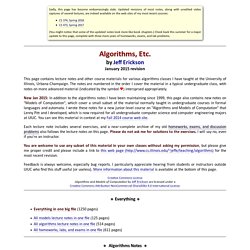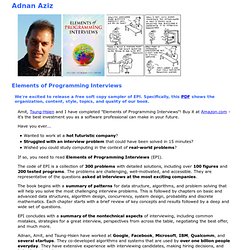

Problems. 4.5 Discussion and Exercises. Java Algorithms and Clients. Top 10 Algorithms for Coding Interview. PDF: Update History, Latest version (8/1/2016) The following are the common subjects in coding interviews.

As understanding those concepts requires much more effort, this tutorial only serves as an introduction. The subjects that are covered include: 1) String/Array/Matrix, 2) Linked List, 3) Tree, 4) Heap, 5) Graph, 6) Sorting, 7) Dynamic Programming, 8) Bit Manipulation, 9) Combinations and Permutations, and 10) Math Problems. I highly recommend you to read "Simple Java" first, if you need a brief review of Java basics. If you want to see code examples that show how to use a popular API, you can use JavaSED.com. 1. An algorithm problem's input is often a string or array. 2. Common methods to solve matrix related problem include DFS, BFS, dynamic programming, etc. Data Structure Visualization. Linked List Queue Visualization. A personal view of the theory of computation. Jeff Erickson's Algorithms. Sadly, this page has become embarrassingly stale.

Updated revisions of most notes, along with unedited video captures of several lectures, are indeed available on the web sites of my most recent courses: (You might notice that some of the updated notes look more like book chapters.) Check back this summer for a major update to this page, complete with three more years of homeworks, exams, and lab problems.
This page contains lecture notes and other course materials for various algorithms classes I have taught at the University of Illinois, Urbana-Champaign. Neopythonic. Lectures 1 and 2: Analysis of Algorithms. I just finished watching the last lecture of MIT's "Introduction to Algorithms" course.

Having a great passion for all aspects of computing, I decided to share everything I learned with you, my dear readers! This is the first post in an article series about this course. As I wrote earlier, I am very serious about watching video lectures. If they are math-intensive, I usually take notes as if I were in the classroom. Lectures in this course were exactly like that -- logarithms, big-o's, thetas, expectations, and all the other math guys fighting with each other on the blackboards.
Calculate the sum of long numbers - James Chen's C/C++ Home. Reverse a linked list in java « Think ! If you search for it you will get millions of solutions but sadly (like many things in internet) the first few solutions seem unintuitive and unnecessarily complex for such a simple problem, not sure why, anyway putting mine out there for somebody to point out why I should go for a more complex solution.

[in java for a change] Idea : Use two references and reverse their links and proceed till we reach the end public void reverse_iterative { if(isEmpty()) { return;} //curr == null Node currNode,nextNode , loopNode; currNode = head; nextNode = head.next; head.next = null; while(nextNode ! = null) { loopNode = nextNode.next; nextNode.next = currNode; currNode = nextNode; nextNode = loopNode; } head = currNode; } Recursive Idea : Reverse the sublist starting from second node and point the second node to first, apply this recursively. Share This. Vkostyukov/finagle-fibonacci. Sorting Algorithm Animations. Algorithms in Java, Parts 1-4, 3rd edition by Robert Sedgewick. Addison Wesley, 2003. Quicksort is Optimal by Robert Sedgewick and Jon Bentley, Knuthfest, Stanford University, January, 2002. Dual Pivot Quicksort: Code by Discussion.
CS 240 Computer Science II Syllabus. Spring 2008 SYLLABUS This page last changed 6/19/08 Objectives: To develop skills in the design and development of computer software continuing to utilize an object-oriented language, packages, modules and libraries.

To develop understanding and build skills in the implementation and use of common data structures used in software development through data abstraction. To further study the Java language and learn to use UNIX as a software design environment. This course's prerequisite is CS 110. Open Data Structures (in Java) Dictionary of Algorithms and Data Structures. CPSC490 - Problem Solving in Computer Science. Sphere Online Judge (SPOJ) - Problems. Algorithm Tutorials. Big-O Algorithm Complexity Cheat Sheet. Adnan Aziz. Elements of Programming Interviews We're excited to release a free soft copy sampler of EPI.

Specifically, this PDF shows the organization, content, style, topics, and quality of our book. Maratona/Facebook at master · arthurguima/maratona. / - elements-of-programming-interviews - Solutions to Elements of Programming Interviews: 300 Questions and Solutions. Markov Chains – Explained. Markov Chains is a probabilistic process, that relies on the current state to predict the next state.

For Markov chains to be effective the current state has to be dependent on the previous state in some way; For instance, from experience we know that if it looks cloudy outside, the next state we expect is rain. We can also say that when the rain starts to subside into cloudiness, the next state will most likely be sunny. Not every process has the Markov Property, such as the Lottery, this weeks winning numbers have no dependence to the previous weeks winning numbers.
Scalgorithms - Algorithms and Data-Structures in Scala. Efficient binary tree traversal with two pointers without using a stack - debforit. In this article, we will be discussing about space complexity optimized binary tree traversal techniques.

Four modes of traversals are used quite often in a binary tree. They are pre-order walk, in-order walk, post-order walk and level first walk. Except the level first traversal, all the others are recursive and hence require a stack for traversal. We would talk here about in-order traversal. Our analysis can be applied to the other two traversal procedures as well. 52233 Algorithms and Data Structures. Csclab.murraystate.edu/bob.pilgrim/445/index.html.
Introduction to Programming in Java: An Interdisciplinary Approach. A textbook for a first course in computer sciencefor the next generationof scientists and engineers Textbook.

Our textbooks Introduction to Programming in Java [Amazon · Pearson · InformIT ] and Computer Science [Amazon · Pearson · InformIT ] are an interdisciplinary approach to the traditional CS1 curriculum with Java. We teach the classic elements of programming, using an "objects-in-the-middle" approach that emphasizes data abstraction. We motivate each concept by examining its impact on specific applications, taken from fields ranging from materials science to genomics to astrophysics to internet commerce. Algorithms, 4th Edition by Robert Sedgewick and Kevin Wayne. Lecture Slides for An Introduction to the Analysis of Algorithms. These slides are for the first half of an undergraduate course taught at Princeton, developed to provide an overview of An Introduction to the Analysis of Algorithms and Analytic Combinatorics.

The course format is "introduce-read-discuss". We introduce a set of topics in lecture; students read about the topics and work selected exercises between lectures, and we discuss any questions about the reading and the exercises at the beginning of the next lecture. Each lecture ends with a slide or two giving assignments to be completed before the next lecture and to be discussed at the beginning of the next lecture. What not to do during an interview. CSE101. Stanford / Computer Science III: Programming Paradigms , Academic Earth. Algorithms. Data Structures and Algorithm.
A computer science portal for geeks. Sorting Applications. Sorting algorithms and priority queues are widely used in a broad variety of applications. Our purpose in this section is to briefly survey some of these applications. Sorting various types of data. Our implementations sort arrays of Comparable objects. This Java convention allows us to use Java's callback mechanism to sort arrays of objects of any type that implements the Comparable interface. Transaction example. Which sorting algorithm should I use?
Knowing which algorithm is best possible depends heavily on details of the application and implementation, but we have studied some general-purpose methods that can be nearly as effective as the best possible for a wide variety of applications. Property. In most practical situations, quicksort is the method of choice. Sorting primitive types. Jdk8/jdk8/jdk: 687fd7c7986d src/share/classes/java/util/DualPivotQuicksort.java.